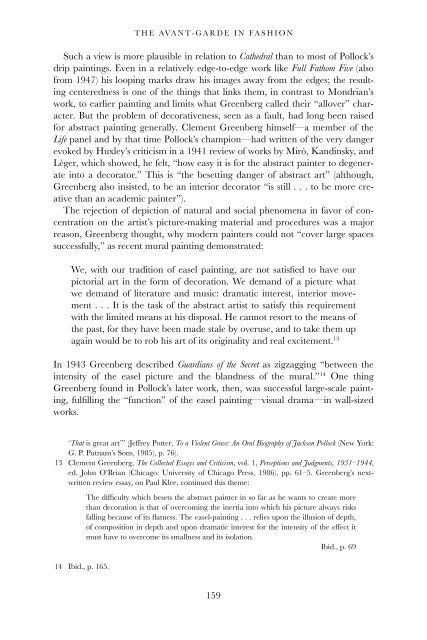Art in its Time: Theories and Practices of Modern Aesthetics
Art in its Time: Theories and Practices of Modern Aesthetics
Art in its Time: Theories and Practices of Modern Aesthetics
You also want an ePaper? Increase the reach of your titles
YUMPU automatically turns print PDFs into web optimized ePapers that Google loves.
Such a view is more plausible <strong>in</strong> relation to Cathedral than to most <strong>of</strong> Pollock’s<br />
drip pa<strong>in</strong>t<strong>in</strong>gs. Even <strong>in</strong> a relatively edge-to-edge work like Full Fathom Five (also<br />
from 1947) his loop<strong>in</strong>g marks draw his images away from the edges; the result<strong>in</strong>g<br />
centeredness is one <strong>of</strong> the th<strong>in</strong>gs that l<strong>in</strong>ks them, <strong>in</strong> contrast to Mondrian’s<br />
work, to earlier pa<strong>in</strong>t<strong>in</strong>g <strong>and</strong> lim<strong>its</strong> what Greenberg called their “allover” character.<br />
But the problem <strong>of</strong> decorativeness, seen as a fault, had long been raised<br />
for abstract pa<strong>in</strong>t<strong>in</strong>g generally. Clement Greenberg himself—a member <strong>of</strong> the<br />
Life panel <strong>and</strong> by that time Pollock’s champion—had written <strong>of</strong> the very danger<br />
evoked by Huxley’s criticism <strong>in</strong> a 1941 review <strong>of</strong> works by Miró, K<strong>and</strong><strong>in</strong>sky, <strong>and</strong><br />
Léger, which showed, he felt, “how easy it is for the abstract pa<strong>in</strong>ter to degenerate<br />
<strong>in</strong>to a decorator.” This is “the besett<strong>in</strong>g danger <strong>of</strong> abstract art” (although,<br />
Greenberg also <strong>in</strong>sisted, to be an <strong>in</strong>terior decorator “is still . . . to be more creative<br />
than an academic pa<strong>in</strong>ter”).<br />
The rejection <strong>of</strong> depiction <strong>of</strong> natural <strong>and</strong> social phenomena <strong>in</strong> favor <strong>of</strong> concentration<br />
on the artist’s picture-mak<strong>in</strong>g material <strong>and</strong> procedures was a major<br />
reason, Greenberg thought, why modern pa<strong>in</strong>ters could not “cover large spaces<br />
successfully,” as recent mural pa<strong>in</strong>t<strong>in</strong>g demonstrated:<br />
We, with our tradition <strong>of</strong> easel pa<strong>in</strong>t<strong>in</strong>g, are not satisfied to have our<br />
pictorial art <strong>in</strong> the form <strong>of</strong> decoration. We dem<strong>and</strong> <strong>of</strong> a picture what<br />
we dem<strong>and</strong> <strong>of</strong> literature <strong>and</strong> music: dramatic <strong>in</strong>terest, <strong>in</strong>terior movement<br />
. . . It is the task <strong>of</strong> the abstract artist to satisfy this requirement<br />
with the limited means at his disposal. He cannot resort to the means <strong>of</strong><br />
the past, for they have been made stale by overuse, <strong>and</strong> to take them up<br />
aga<strong>in</strong> would be to rob his art <strong>of</strong> <strong>its</strong> orig<strong>in</strong>ality <strong>and</strong> real excitement. 13<br />
In 1943 Greenberg described Guardians <strong>of</strong> the Secret as zigzagg<strong>in</strong>g “between the<br />
<strong>in</strong>tensity <strong>of</strong> the easel picture <strong>and</strong> the bl<strong>and</strong>ness <strong>of</strong> the mural.” 14 One th<strong>in</strong>g<br />
Greenberg found <strong>in</strong> Pollock’s later work, then, was successful large-scale pa<strong>in</strong>t<strong>in</strong>g,<br />
fulfill<strong>in</strong>g the “function” <strong>of</strong> the easel pa<strong>in</strong>t<strong>in</strong>g—visual drama—<strong>in</strong> wall-sized<br />
works.<br />
‘That is great art’” (Jeffrey Potter, To a Violent Grave: An Oral Biography <strong>of</strong> Jackson Pollock (New York:<br />
G. P. Putnam’s Sons, 1985), p. 76).<br />
13 Clement Greenberg, The Collected Essays <strong>and</strong> Criticism, vol. 1, Perceptions <strong>and</strong> Judgments, 1931–1944,<br />
ed. John O’Brian (Chicago: University <strong>of</strong> Chicago Press, 1986), pp. 61–5. Greenberg’s nextwritten<br />
review essay, on Paul Klee, cont<strong>in</strong>ued this theme:<br />
The difficulty which besets the abstract pa<strong>in</strong>ter <strong>in</strong> so far as he wants to create more<br />
than decoration is that <strong>of</strong> overcom<strong>in</strong>g the <strong>in</strong>ertia <strong>in</strong>to which his picture always risks<br />
fall<strong>in</strong>g because <strong>of</strong> <strong>its</strong> flatness. The easel-pa<strong>in</strong>t<strong>in</strong>g . . . relies upon the illusion <strong>of</strong> depth,<br />
<strong>of</strong> composition <strong>in</strong> depth <strong>and</strong> upon dramatic <strong>in</strong>terest for the <strong>in</strong>tensity <strong>of</strong> the effect it<br />
must have to overcome <strong>its</strong> smallness <strong>and</strong> <strong>its</strong> isolation.<br />
Ibid., p. 69<br />
14 Ibid., p. 165.<br />
THE AVANT-GARDE IN FASHION<br />
159
















